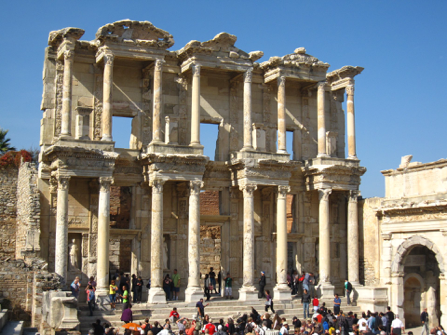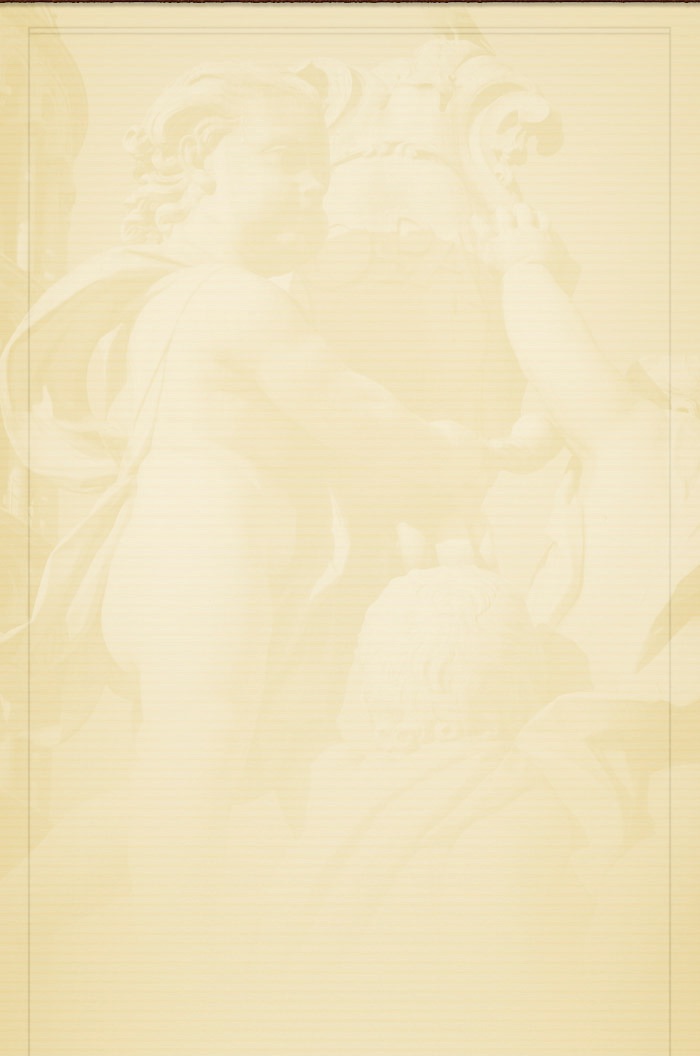

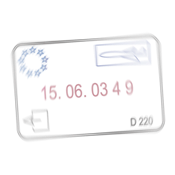


III: Turkish Ports of Call
a: Visiting Kusadasi.
Visiting Kusadasi is a popular pursuit for cruise ships. The city has expanded substantially in recent years, mostly because of the tourist trade. In and around the town there are a number vacation resorts for longer-term stays, mostly frequented by Germans. As a cruise ship passenger, the main reason would be to go inland for a few miles to visit and admire the impressive ruins of the ancient city of Ephesus. This town is well known even in antiquity and is mentioned many times in the Bible.
As Larry, Millie, and the two of us walked out of the cruise terminal a man accosted us and asked us whether we would be interested in going to Ephesus in his taxi. We said: “Not really; but it depends on the price”. So he offered to drive the four of us to Ephesus and back for €80, payable only when he delivered us back to the cruise terminal. Times are hard. So we accepted his offer.
Taxis generally take you to the upper entrance of the archeological site, which is about a 25 minute drive from the cruise terminal over good paved highway roads. Entrance to the site costs 20 turkish liras, which you can pay with a credit card. At US$0.53 per NTL (New Turkish Lira) this would correspond to US$ 10.60. When we were in Turkey in 2002, the exchange rate was 1,360,000 liras for one US$. The Turkish economy has improved rapidly in the last decade. But Larry had the foresight to have some Turkish liras with him. A guide offered us his services for €40, but we declined.
It was the end of October and it was a beautiful, slightly overcast day with the temperature in the 70s. It felt like the San Francisco Bay Area. There were still many tourists around, but much less than half compared to when we were here some 10 years go. It was the end of the season, and the site is huge. So, with a little patience you can easily take pictures with few or no people around. At all the interesting locations there were signs where the site is described and explained in Turkish, English, and German. Skip the Turkish, it is a difficult language. But there are no directional signs so, if you want to see the brothel, which always seems to attract a lot of tourists, you have to ask.
In the 1st century BC, the town had a population of 250,000, which made it one of the largest cities in the Mediterranean. So the area covered by ruins is extensive.
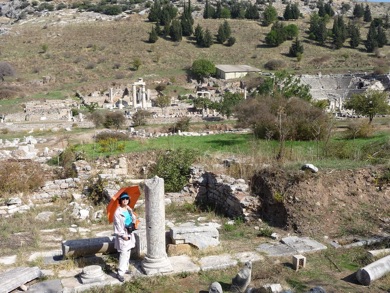
left: partial view of the extensive ruins of Ephesus from the Water Palace, showing the remains of the Basilica in the middle distance on the left, and the Odeum theater in the far right.
In the Eastern Mediterranean, Ephesus has the largest number of Roman ruins; so far, only 15-20 % have been excavated. They are still excavating. So, if you come once every decade you will always see something new. Compared to our last visit there in 2002, there is now a large new section, called “Terrace Houses”, located opposite the Temple of Hadrian. This new exhibit shows reconstructions of buildings of the wealthier citizens, with wall paintings in still brilliant colors and intricate mosaic floors, all under a large protective roofing. They do charge extra for the visitor to go in. But if you have the time, it is probably worth the visit.
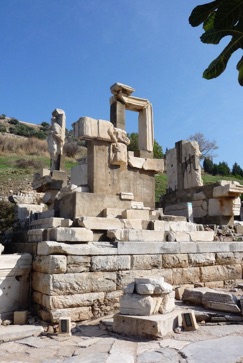
right: Memmius Monument, from the 1st century BC. Gaius Memmius was the grandson of dictator Sulla.
The sad remains of one of the seven wonders of the Ancient World, the Temple of Artemis, is also located here. There is almost nothing left of the Temple now; twelve of the main columns have been taken away and can now be viewed inside the Church of Aya Sophia in Istanbul.
With the hundreds of other tourists, we walked down Curetes Street, the main street once lined with shops and inns and in many sections covered with mosaics. The crowd took us to the most photographed site, the Library of Celsus, originally built in 125 AD, in memory of Mr. Celsus, obviously. The facade has been meticulously reconstructed. Tiberius Julius Celsus Polemaenus served as Governor of Roman Asia in the Roman Empire. When he died, the 90,000 talents he left behind was used to design this library and which is also his tomb. At one time it had as many as 25,000 volumes.
Contrary to stories in some guidebooks, Cleopatra did not take these volumes to Alexandria. This would have been a miracle, because she lived more than a century earlier.
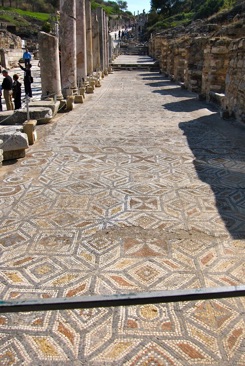
left: the mosaic-covered sidewalk of Curetes Street close to the area of the “Terrace Houses”
At the end of our visit, we walked on the Via Mare, which was the road to the harbor. The harbor used to be at the end of this street, but silting of the Meandros river has moved the sea some 7 kms out in the last 2000 years. On the Via Nare in the distance you can see the top of mountain where the apostle Paul was incarcerated for two years.
This street was lighted in the evenings with torches stuck in columns, the first public lighting in the evening. The torches were made from the nartex plant which, after drying, can burn as long as 5-6 hours.
In the current setup, halfway down this road you go to the right and a few hundred yards away is the exit of the archeological site. Just outside it are the taxi stands. Our taxi was expecting us 1 1/2 hours after he dropped us off, the average length of the time a visitor spends here.
At the point where this picture was taken 9 years ago we just happened to see a number of costumed actors reenacting a period of ancient Rome. There was a royal emperor trying his best to look like Marc Anthony, an imperious looking Cleopatra, trumpeting heralds, a motley collection of not too martially looking centurions, white-robed dancing temple girls, and fake gladiators fighting with wooden swords to the death (almost).
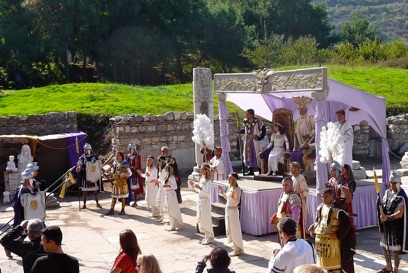
right: Theater on the road
The town was closely connected to early Christianity. The apostle Paul lived here between 52-54 AD. The Apostle John may have written his Gospel here.
Close by is the house of the Virgin Mary, believed to be the last home of Mary. Three recent popes have visited the church built over the house. For the record it should be stated that there is another place in Antioch and two other places in Jerusalem, who also claim this honor. These are important tourist destinations and beloved by the local economy; the one I visited in Jerusalem several years ago was, e.g., highly decorated.
The local authorities and the storekeepers in each of these places obviously maintain theirs is the one and only true place, heaping scorn and ridicule on the others. And please buy a souvenir, maybe several, to remember your visit and to help me feed my starving children..
The taxi man was waiting for us. He drove us to the church of St. Jean, close to the castle of St. Jean, just to take a few pictures. Then he drove us back to the terminal.
In the afternoon, I walked to Güvercin Ada (Pigeon Island), which is connected a the mainland by a long narrow strip of land, about 2 miles from the cruise terminal. There was an old Genoese fortress on the island, but it was closed and locked. It was not exactly a tourist venue.
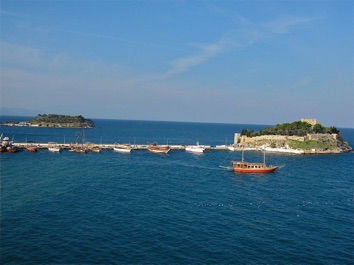
left: Pigeon Island, as seen from the cruise ship.
Not too many tourists come here, obviously, Along this strip of land was the harbor of many gaily decorated tourist boats for day trips in the surrounding Aegean Sea. Even German tourists needed something else to do besides getting sunburn on the beaches.
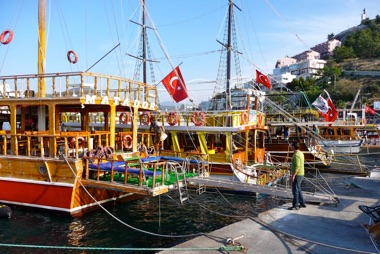
right: Sightseeing pleasure boats with gaily waving Turkish flags in the harbor of Kusadasi, about 2 miles from the cruise ship terminal.
b: Antalya
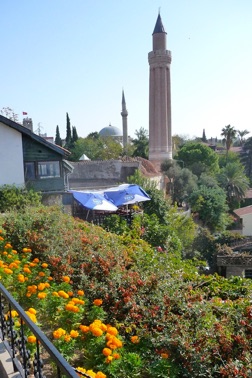
left: The Fluted Minaret, the symbol of the city. This minaret, 38 meters high, was also at one time a Byzantine Church, later converted into a mosque.
Antalya is also a popular stop for cruise ships. It is a large metropolitan area with a population over a million. It was said that in the 2nd century BC, the Pergamon king Attalos II ordered his men to find “Heaven on Earth”. After a presumably extensive search his men came up with the city of Antalya, giving it the name of Attaleia (Ατταλεια). For the older male tourists, it is indeed heaven on earth because there are public toilets everywhere. It does cost 1 NTL (New Turkish Lira), which was about $0.56, to go inside to take care of business.
Our cruise ship moored quite a distance from old Antalya, but a free shuttle bus was provided to get us to Kaleici, the historical center and heart of the shopping district. By bus it was 25 minutes one way, so it was not practical to walk. And the merchants want to be sure you would come and visit them.
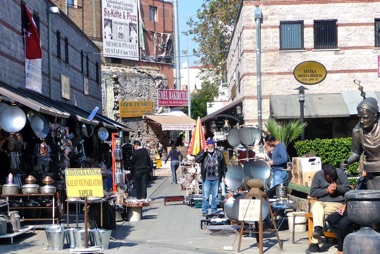
right: The Street of the Ironmongers. Beside utilitarian articles they also display metal sculptures for the tourists, some of them a bit too large to carry in a suitcase back home.
It was indeed quite a beautiful city, even with the surfeit of souvenir shops. But the markets were also carrying other interesting and more useful stuff for use by the local population. The picture above shows a street with mostly ironmongers.
With its often narrow streets, It is easy to lose your way downtown. And yet there were many car rental agencies there, I suppose for the discombobulated tourist who would like driving in circles in town.
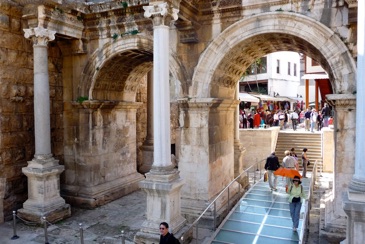
left: Hadrian’s Gate.
We walked by Hadrian’s Gate, a triumphal gate with three arches, built in honor of the Roman emperor Hadrian on the occasion of his visit to this town in AD 130. The columns are Corinthian in style, with two or three rows of acanthus leaves on its lower and middle sections.
Legend has it that Sultan Belkis, the Queen of Saba, also passed below these arches on her way to visit king Solomon in Antalya. King Solomon, in an apocryphal story, was said to be more interested in how her legs looked like, so he had her walk on a glass floor when she came to see him. The queen, believing she was walking over water, lifted up her skirts. Whatever the outcome, Queen Belkis seemed to have enjoyed many happy days in the palace in Aspendos.
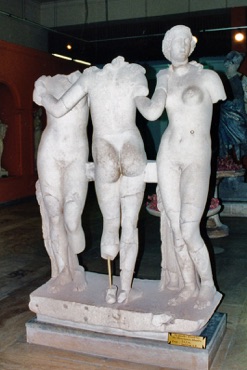
right: The Three Graces in the Antalya Museum of Archeology.
We visited the Antalya Museum about ten years ago. Not this time. They have a good collection of sculptures recovered from the city of Perge close by. But the best pieces are not there anymore. They are spread out in museums all over the world. The marble sculpture of the Three Graces shown on the right dates to the 2nd century and is still there.
People in those days often carry a container with olive oil with which to rub the bas-reliefs of gods and goddesses as a mark of piety. In the middle sculpture you can see that over the centuries the buttocks and the crease have been lovingly rubbed by generations of men, each and everyone of them brimming with piety; and barely concealed carnal desire.
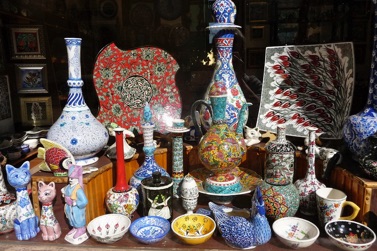
left: They make very nice hand-painted colorful ceramic decorative plates, bowls, urns, etc.
The artisans in the area do a lot with earthenware. Besides the classical forms, some studios are experimenting with newer and more modern designs.
c: Perge and Aspendos.
Of the places on the outskirts of Antalya I just wanted to mention Perge and Aspendos, which we visited the last time we were here. The ancient city of Perge, about 12 miles outside Antalya had, at its apex, a population of around 120,000. It was destroyed in the 7th-8th century AD. Perge used to be an important harbor town, but the silting of the land was so rapid, that in a few centuries the water was several miles away from the town.
Close to Perge is the ancient city of Aspendos. The most striking relic is the huge and beautiful theater, commissioned by the emperor Marcus Aurelius (161-181 AD), The theater of Aspendos has almost perfect acoustics and was, until recently, used regularly for international concerts and festivals. Modern theater equipment caused damage during one of the performances. So no more performances there, said the Minister of Culture. With a diameter of 315 feet, it can seat 7,000.
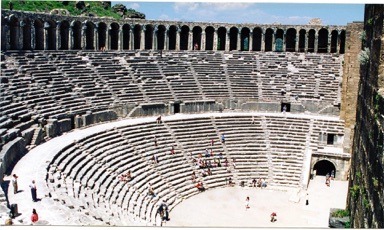
right: The magnificent ruins of the Roman theater of Aspendos,
